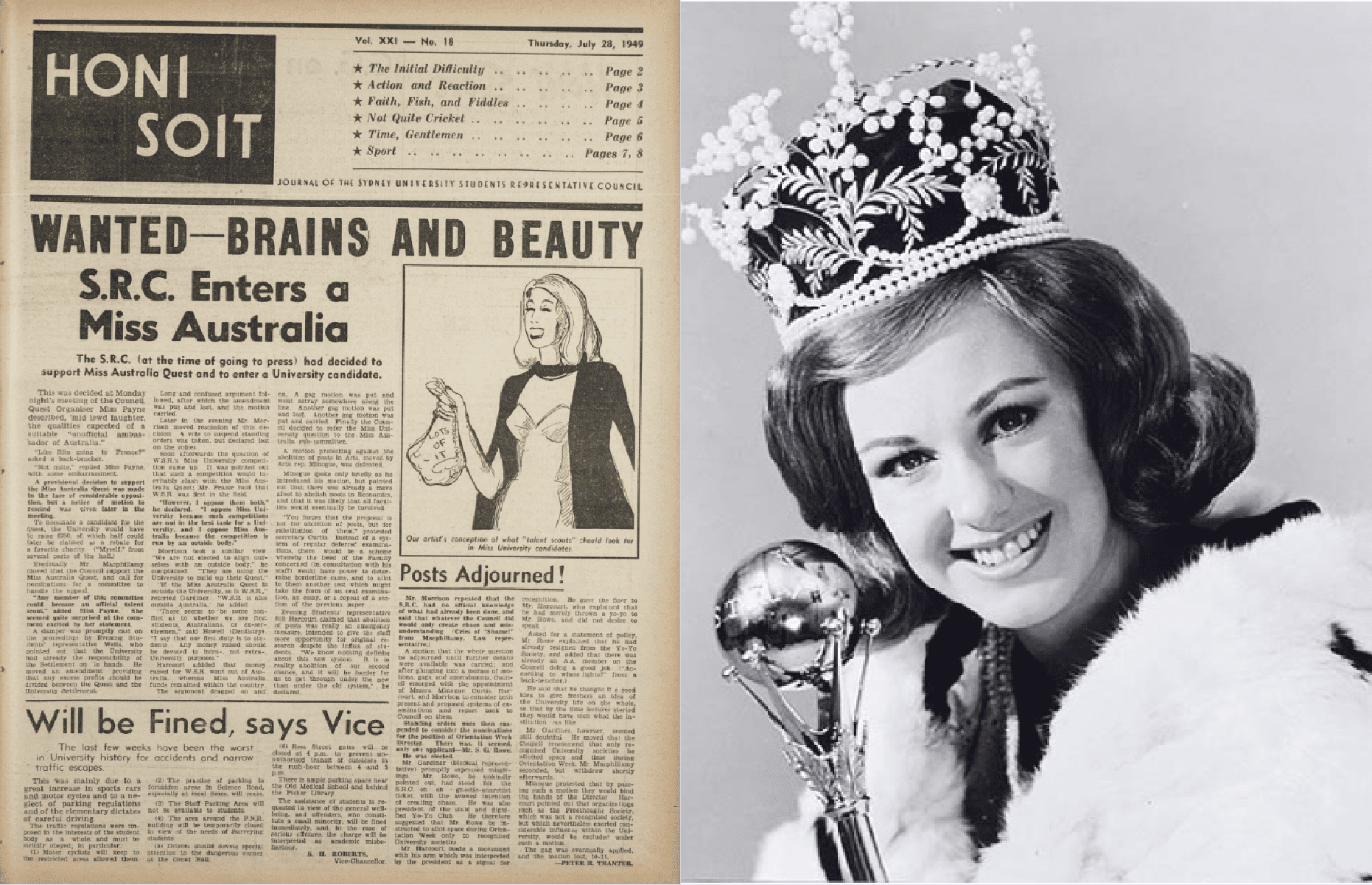Traversing through the Honi archives, as I often do (check out @honi_soit on TikTok to see why), I was baffled by a particular image I encountered in a 1949 edition of the paper. ‘WANTED—BRAINS AND BEAUTY,’ reads the headline, ‘S.R.C. Enters a Miss Australia.’
Anyone familiar with the USyd Students Representative Council of the modern era would find this a bizarre headline. Now, it’s an organisation occupied with serious activism like combatting cuts to education and campus sexism. It seems a very, very far cry from the beauty pageant participating student union of the post-war era!
Curiosity piqued, I took a flip through the archives to find out more.
The original 1949 article states that “mid lewd laughter”, the SRC had resolved to select a candidate to compete in the Miss Australia Quest.
The Miss Australia Quest began in 1908, and ran until 2000. Run as a charitable fundraiser, it operated separately to the Miss World and Miss Universe pageants and peaked in popularity in the 1950s and 60s. Images from the National Museum of Australia depict the charming Miss Australia crown (worn by the national winner until 1992), which was a gift from the Toyomoto company and featured Japanese pearls in a wattle design.
Pictured: 1949 winner Margaret Hughes (credit: NMA)
The 1949 paper writes that debate within the council raged about whether the Miss Australia Quest would compete with the existing ‘Miss University Quest’. More bizarre still! Another beauty pageant, a competitor, on our hands!
But what was the Miss University pageant? This one is more obscure, stubbornly refusing to appear when Googled, conflated with the ubiquitous Miss Universe franchise. I dug further into the archives to find out.
Issues from the 1950s portray the Miss University contest as a highly competitive activity. ‘Three enter already!’ urges a 1957 edition of the paper. The competition drew out the BNOCs, such as “Binkie Stafford, the well-known and very popular Arts personality” or “Jill Woolacott, darling of the SRC.” It was run through the SRC officer (which, conveniently, took in registration fees!) and photos of the contestant were published in Honi. It conjures an amusing mental picture of the Big Names On Campus of the modern day competing for the Miss University title — honestly, I can almost imagine it.
Shockingly, 1957 Honi clearly needed to up its editorial standards. A few editions later they published a shameful retraction, noting that Jill Woolacott “is not and never has been a candidate for the title”. Embarrassing! However, Arts Society candidate and “child prodigy” Carole McGregor enjoyed the “heavy backing of the SRC clique” instead.
Hooked to the evolving ‘57 Pageant narrative, I flipped to the second-last edition to find out who won: the lucky, and “exceptionally popular” candidate Janet Britten, who hailed from Engineering. Lucky Britten won a free trip to anywhere in Australia, telling Honi “I’m so thrilled to have won, I don’t know where to go”.
Image: 1960 Honi edition on Miss University.
I struck (dubious) archival gold with another article from 1960. ‘More Joy Into Your Sad Lives’ promises the headline, before covering a beauty contest to be held in the Wallace Theatre which will judge its contestants on the basis of “poise, personality and anything else they have”. Lovely.
The contest was a fundraising event at its core, with competitors required to raise money for a shot at the title. The funds were to go to a “very worthy cause”: the World University Service, an international organisation which apparently helped students in “underprivileged countries”. The WUS was founded in the aftermath of World War 1 to help students and academics after the war, before shifting its focus after World War 2 to combating educational disadvantage. The organisation is still active in some countries
Despite the ultimately altruistic intent of the pageant, it still came with a solid serve of sexism: the article gleefully claims “the men are running hot and cold” at the prospect — evidently the 1960 editorial team felt this objectification was nothing out of the ordinary.
What does all of this pageantry say about the role of women in the mid-20th century University? Well, it seems to be a complex one. It’s weird to think about a university-affiliated beauty contest, but the archives also reveal all sorts of women’s clubs: chess, swimming, sports clubs. It was a complex time to be a woman in a still-very-male institution — one in which you were clearly something of a novelty, but also where female students were nonetheless creating a place for themselves.
Image: From a 1940 edition — the role of women at USyd was complex and active.





